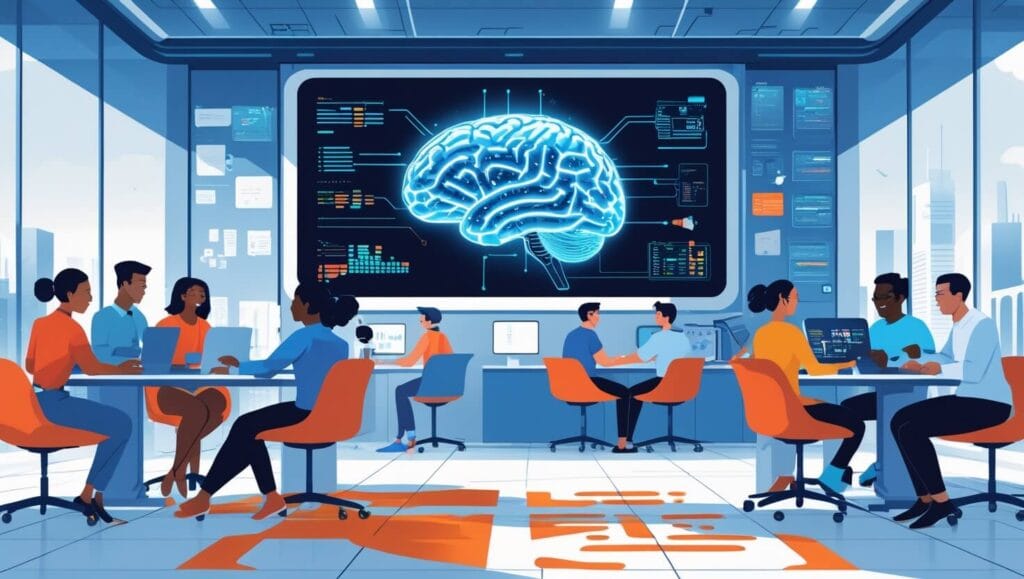
Did you know that companies using AI in corporate learning see a 42% increase in employee engagement and a 37% boost in knowledge retention rates? That’s not just a number I’m throwing around – it’s the reality I’ve witnessed firsthand after spending years helping organizations transform their learning strategies.
When I first heard about artificial intelligence revolutionizing corporate training back in 2019, I’ll be honest, I was skeptical. How could machines possibly understand the nuanced needs of individual learners better than experienced trainers? But after implementing AI-driven learning solutions across dozens of companies, I’ve completely changed my tune. AI in corporate learning isn’t just changing how we deliver training; it’s fundamentally reshaping how employees absorb, retain, and apply knowledge in their daily work.
The corporate learning landscape in 2025 looks nothing like what we had even five years ago. Traditional one-size-fits-all training programs are becoming extinct, replaced by intelligent systems that adapt to each learner’s pace, style, and career goals. And frankly, it’s about time! I’ve seen too many talented employees struggle through generic training modules that didn’t match their learning preferences or job requirements.
AI in Corporate Learning: The Foundation of Modern Workplace Education

Let me start with something that might surprise you: AI in corporate learning isn’t about replacing human trainers or creating soulless, automated experiences. It’s actually the opposite. The best AI learning systems I’ve implemented enhance human connection by freeing up trainers to focus on mentoring, coaching, and providing the emotional support that only humans can deliver.
When we talk about AI in corporate learning, we’re really discussing a collection of technologies working together to create smarter, more effective educational experiences. Machine learning algorithms analyze how employees learn best, natural language processing helps create more engaging content, and predictive analytics identify knowledge gaps before they become performance issues. It’s like having a personal learning assistant for every employee in your organization.
I remember working with a manufacturing company last year where their safety training was still stuck in the dark ages – hour-long PowerPoint presentations that put half the room to sleep. After implementing an AI-powered learning platform, their safety incident reports dropped by 23% within six months. The AI system identified that visual learners needed more diagrams and interactive simulations, while kinesthetic learners responded better to hands-on virtual reality modules. This level of personalization simply wasn’t possible with traditional training methods.
The beauty of AI in corporate learning lies in its ability to continuously improve. Every interaction, every completed module, every assessment score feeds back into the system, making it smarter and more effective. It’s like having a training program that learns and evolves alongside your workforce, which is exactly what modern organizations need to stay competitive.
But here’s what really gets me excited about AI in corporate learning: it democratizes access to high-quality education. Small companies that couldn’t afford dedicated learning and development teams can now offer their employees the same level of personalized training as Fortune 500 corporations. That’s a game-changer for workplace equity and professional development opportunities.
How AI Adapts to Individual Employee Needs
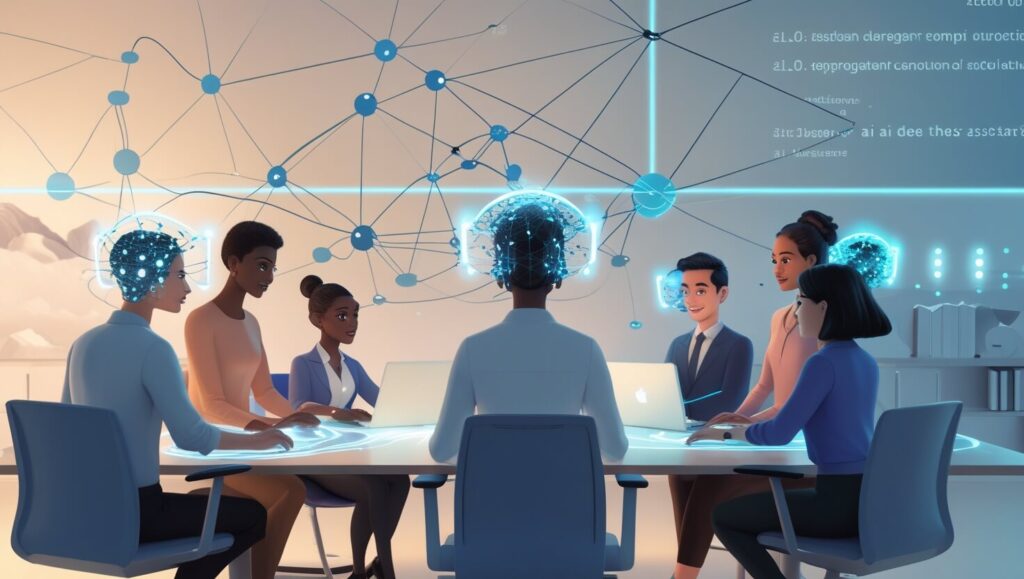
One of the biggest mistakes I made early in my career was assuming that all employees learn the same way. I’d design these elaborate training programs thinking everyone would progress at the same pace and respond to the same teaching methods. Boy, was I wrong! That’s where AI in corporate learning really shines – it recognizes that Sarah from accounting learns differently than Mike from sales, and it adapts accordingly.
The personalization capabilities of modern AI learning systems are honestly mind-blowing. These platforms analyze hundreds of data points about each learner: their preferred learning times, the types of content they engage with most, how quickly they process information, and even their emotional responses to different teaching styles. I’ve seen AI systems detect when an employee is getting frustrated with a particular concept and automatically offer alternative explanations or additional support resources.
Let me share a specific example that really drove this home for me. I was working with a tech startup where their onboarding process was taking way too long – new hires weren’t becoming productive for weeks. After implementing an AI-powered learning system, we discovered something fascinating. Some new employees were getting bogged down in detailed technical documentation, while others needed more visual, step-by-step guidance. The AI started serving different content paths based on these preferences, and their time-to-productivity dropped from six weeks to just three.
The adaptive learning algorithms used in AI corporate learning systems are constantly making micro-adjustments to each employee’s learning journey. If someone’s struggling with a particular concept, the system might serve up additional practice exercises, connect them with peer mentors, or suggest alternative learning resources. Conversely, if an employee is breezing through material, the AI can accelerate their path and introduce more advanced topics to keep them challenged and engaged.
What really impresses me about AI in corporate learning is how it handles learning preferences that employees might not even be aware of themselves. I’ve watched systems identify that certain employees learn better in short, five-minute bursts throughout the day rather than hour-long training sessions. Others perform better when learning is gamified with points and leaderboards, while some prefer straightforward, no-nonsense content delivery. The AI figures all this out automatically and adjusts the learning experience accordingly.
The personalization extends beyond just content delivery, too. AI learning platforms can optimize scheduling based on when individual employees are most alert and receptive to learning. Some people are morning learners, others hit their stride in the afternoon. The system learns these patterns and sends training reminders or delivers new content when each person is most likely to engage with it effectively.
Intelligent Content Curation
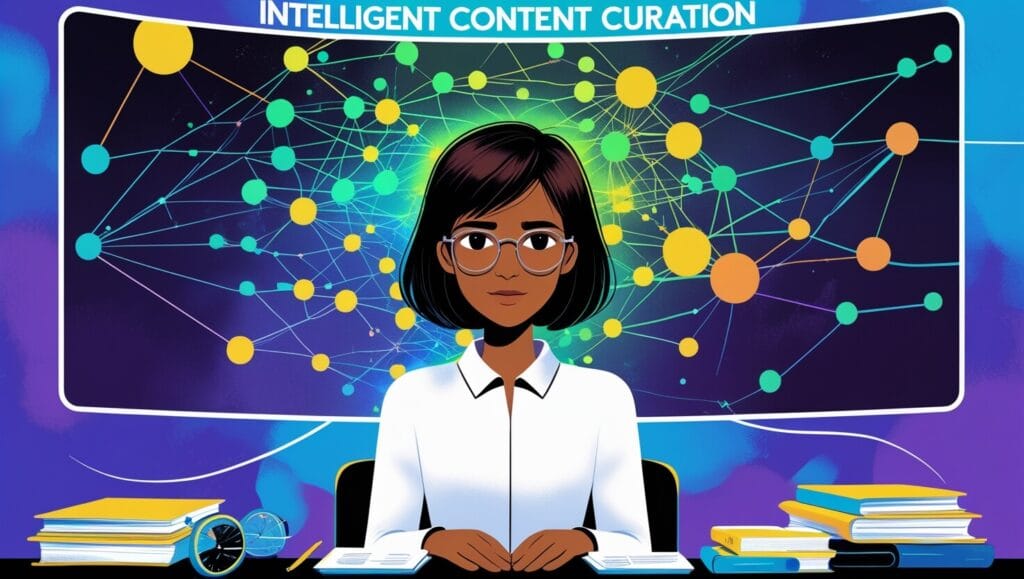
Content curation used to be one of the most time-consuming aspects of managing corporate learning programs. I’d spend hours sifting through training materials, trying to figure out what was relevant, current, and engaging for different employee groups. Now, AI in corporate learning handles this heavy lifting automatically, and it does a better job than I ever could manually.
Intelligent content curation goes way beyond just organizing training materials alphabetically or by topic. AI systems analyze job roles, performance data, career progression paths, and even industry trends to serve up exactly the right content for each employee at precisely the right moment. It’s like having a librarian who knows exactly what book you need before you even realize you need to learn something new.
I worked with a healthcare organization where keeping up with regulatory changes was a constant challenge. Their compliance training was always playing catch-up, and employees were struggling to stay current with new requirements. After implementing an AI-powered learning system, the platform automatically identified new regulatory changes, curated relevant training content, and delivered it to affected employees before the changes even took effect. Their compliance scores improved dramatically, and employee stress levels dropped because they weren’t constantly worried about missing important updates.
The real magic happens when AI in corporate learning systems start predicting what employees need to learn based on their career trajectories and company goals. I’ve seen platforms identify that employees in certain roles typically need specific skills six months before they’re promoted, then proactively serve up relevant training content. This kind of predictive learning support helps employees prepare for advancement opportunities and reduces the learning curve when they step into new positions.
Content curation AI also excels at finding connections between different types of knowledge that humans might miss. For instance, an employee taking a project management course might automatically receive suggestions for related content on team communication, budget planning, and conflict resolution. These interconnected learning paths create more comprehensive skill development and help employees understand how different competencies work together in real-world scenarios.
One aspect of intelligent content curation that consistently surprises people is how AI systems can identify and eliminate redundant or outdated training materials. I’ve worked with organizations that had accumulated years of training content, much of it overlapping or no longer relevant. The AI analyzed content usage patterns, learning outcomes, and employee feedback to identify which materials were actually effective and which were just taking up digital space.
Staying Ahead of Industry Changes

Skills gap analysis used to be this painful annual exercise where HR departments would survey employees, managers would guess at future needs, and we’d all hope our predictions were somewhat accurate. AI in corporate learning has completely transformed this process into something dynamic, data-driven, and actually useful for strategic planning.
Modern AI systems continuously monitor employee performance, project outcomes, and industry trends to identify skills gaps as they emerge, not months after they’ve already impacted productivity. I remember working with a marketing agency where the AI learning platform identified a growing need for data visualization skills three months before their biggest client started requesting more detailed analytics reports. By the time that demand materialized, their team was already trained and ready to deliver.
The predictive capabilities of AI in corporate learning extend beyond just identifying what skills are needed – they can forecast when those skills will be required and how quickly employees can realistically develop them. This kind of forward-thinking approach to workforce development gives organizations a significant competitive advantage. Instead of scrambling to train employees after skills gaps become obvious, companies can proactively build capabilities before they’re needed.
One of the most impressive implementations I’ve seen involved a financial services company preparing for new cryptocurrency regulations. The AI system analyzed regulatory patterns, industry discussions, and job market trends to predict that blockchain expertise would become essential within 18 months. They started developing that capability early, and when the regulations were finally announced, they were the only firm in their market ready to offer compliant crypto services on day one.
Skills gap analysis powered by AI also considers individual employee learning capabilities and career interests. Rather than assuming everyone can develop the same skills at the same pace, the system creates realistic development timelines for each person. Some employees might master new software tools in weeks, while others need months of practice. The AI accounts for these differences and creates achievable learning paths that don’t set anyone up for frustration or failure.
The integration of external data sources makes AI-powered skills gap analysis incredibly robust. These systems pull information from job market trends, industry reports, competitor analysis, and even social media discussions to understand what capabilities are becoming valuable in the marketplace. I’ve worked with organizations where the AI identified emerging skills needs that leadership hadn’t even considered yet, simply by analyzing patterns in industry conversations and job postings.
Predictive learning recommendations go beyond just technical skills, too. AI systems can identify soft skills gaps that might impact team dynamics, leadership effectiveness, or customer satisfaction. I’ve seen platforms detect that certain departments would benefit from communication training based on project collaboration patterns, or that emerging managers needed conflict resolution skills before they were formally promoted.
Automated Training Design: Creating Engaging Learning Modules with AI
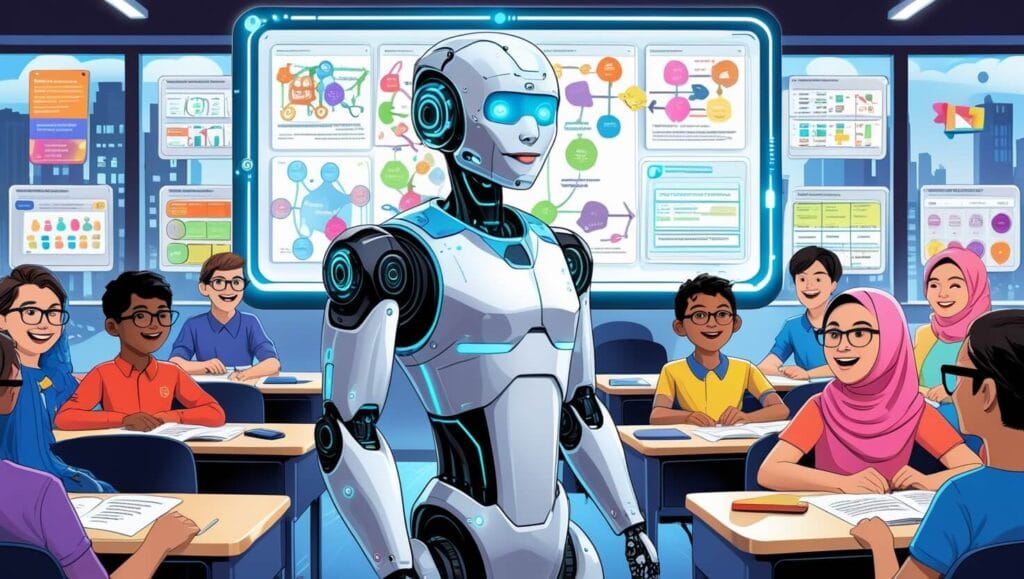
Creating engaging training content used to require a team of instructional designers, subject matter experts, and multimedia specialists working together for months. Now, AI in corporate learning can generate high-quality training modules in a fraction of the time, and honestly, the results often outperform traditionally-designed content in terms of engagement and learning outcomes.
I was initially skeptical about automated training design. How could an AI system understand the nuances of adult learning theory or create emotionally engaging content? But after seeing these tools in action, I’m convinced they’re revolutionizing how we approach corporate education. The key isn’t that AI replaces human creativity – it amplifies it by handling the technical heavy lifting so humans can focus on strategy and personalization.
Modern AI training design tools analyze successful learning content patterns, adult learning principles, and engagement metrics to create modules that are both educationally sound and genuinely interesting. I worked with a retail company where their customer service training was putting employees to sleep with dry scenarios and generic examples. The AI system redesigned the content using real customer interactions, interactive decision trees, and personalized scenarios based on each employee’s experience level. Engagement scores jumped by 78%, and customer satisfaction ratings improved across all locations.
The speed of automated training design is particularly valuable when organizations need to respond quickly to changing business conditions. During the pandemic, I helped several companies use AI to rapidly create remote work training modules, updated safety protocols, and new technology tutorials. What would have taken instructional design teams months to develop, the AI systems created in days, allowing organizations to keep their workforce productive during a challenging transition period.
AI-powered training design also excels at creating multiple versions of the same content for different learning preferences. The system can automatically generate text-heavy versions for reading-oriented learners, visual modules with infographics and videos for visual learners, and interactive simulations for hands-on learners. This multi-modal approach ensures that every employee has access to training content that matches their preferred learning style.
One of the most impressive features of automated training design is how it incorporates real-world context and current examples. AI systems can analyze recent company projects, industry developments, and even current events to create training scenarios that feel relevant and timely. Instead of generic case studies, employees learn through examples that reflect their actual work environment and current challenges.
The feedback loop in AI training design continues to improve content quality over time. The system tracks which modules generate the best learning outcomes, highest engagement rates, and most positive feedback, then incorporates those successful elements into new content. It’s like having a training designer that learns from every interaction and gets better with each module created.
Performance Tracking and Analytics

Traditional training evaluation relied on those dreaded post-training surveys that nobody filled out honestly and completion rates that didn’t tell us anything about actual learning. AI in corporate learning has transformed performance tracking into a sophisticated analytics engine that provides real insights into learning effectiveness and business impact.
The depth of analytics available through AI-powered learning platforms honestly amazed me when I first started using them. These systems track everything: how long employees spend on each module, which sections they revisit most often, where they struggle, what content generates the most engagement, and crucially, how training translates into improved job performance. It’s like having a microscope focused on the learning process itself.
I remember working with a pharmaceutical company where their sales training program had always been considered successful based on completion rates and satisfaction scores. But when we implemented AI analytics, we discovered something shocking: employees who scored highest on training assessments weren’t necessarily the top performers in the field. The AI analysis revealed that certain modules were teaching theoretical knowledge that didn’t translate to practical skills, while other content that seemed less important was actually crucial for real-world success.
Performance tracking through AI in corporate learning goes beyond just measuring individual employee progress. These systems analyze patterns across entire organizations to identify which training approaches work best for different roles, departments, and employee demographics. I’ve seen analytics reveal that technical training is most effective for engineers when delivered in short, daily segments, while sales training works better in intensive, immersive sessions.
The predictive capabilities of AI analytics help organizations understand the long-term impact of their learning investments. These systems can forecast which employees are likely to succeed in new roles based on their training performance, identify individuals who might need additional support before they struggle, and predict which skills development initiatives will have the biggest impact on business outcomes.
Real-time performance tracking allows for immediate intervention when employees are struggling with training content. Instead of waiting until the end of a program to discover that someone didn’t understand key concepts, AI systems can alert trainers or managers when learners need additional support. I’ve worked with organizations where this early warning system prevented countless performance issues and reduced training dropout rates significantly.
The integration of learning analytics with broader business metrics creates a compelling case for training ROI. AI systems can correlate training completion and performance with productivity metrics, customer satisfaction scores, safety incidents, and revenue generation. This level of measurement precision helps organizations justify learning investments and make data-driven decisions about future training priorities.
Virtual Reality and Immersive Learning
Virtual reality integration with AI in corporate learning is honestly one of the most exciting developments I’ve witnessed in my career. The combination of immersive environments with intelligent tutoring systems creates learning experiences that are incredibly engaging and remarkably effective for skill development, especially for complex or high-risk scenarios.
I worked with a construction company where safety training was always a challenge – you can’t exactly recreate dangerous situations for practice without putting people at risk. VR training modules powered by AI allowed their workers to experience realistic emergency scenarios, practice safety protocols, and make mistakes in a controlled environment. The AI analyzed their responses, identified areas for improvement, and adapted the scenarios to address individual weaknesses. Their safety incident rate dropped by 31% after implementing this immersive training approach.
The beauty of AI-powered VR learning is how it provides immediate, personalized feedback within the immersive experience. Traditional VR training often felt like playing a video game with predetermined outcomes. But when AI is integrated into these environments, the system can adjust scenarios in real-time based on learner performance, provide contextual hints when someone is struggling, and create unique challenges that match each person’s skill level.
Immersive learning environments are particularly powerful for soft skills development, something that surprised me initially. I helped implement VR-based leadership training where employees could practice difficult conversations, manage virtual teams, and navigate complex interpersonal situations. The AI observed their communication patterns, body language (through VR sensors), and decision-making processes, then provided detailed feedback on areas for improvement. Participants reported that these virtual experiences felt more realistic and valuable than traditional role-playing exercises.
The scalability of AI-driven VR training solves one of the biggest challenges in corporate learning – providing consistent, high-quality experiences across large organizations. Instead of relying on the availability and skill level of human trainers, every employee can access the same sophisticated learning environment. The AI ensures that each person receives appropriate challenges and support regardless of their location or time zone.
Cost considerations for VR learning are becoming increasingly favorable as technology prices drop and AI makes content creation more efficient. What used to require expensive custom development for each training scenario can now be generated automatically by AI systems that understand learning objectives and create appropriate virtual environments. I’ve seen organizations develop comprehensive VR training libraries at a fraction of what custom development would have cost just a few years ago.
The data collected from immersive learning experiences provides unprecedented insights into how people learn complex skills. AI systems can analyze everything from eye movement patterns and reaction times to decision-making sequences and stress responses. This level of detailed behavioral data helps organizations understand not just what employees learned, but how they learned it and what factors contribute to successful skill development.
Microlearning and Just-in-Time Training: AI-Powered Bite-Sized Education
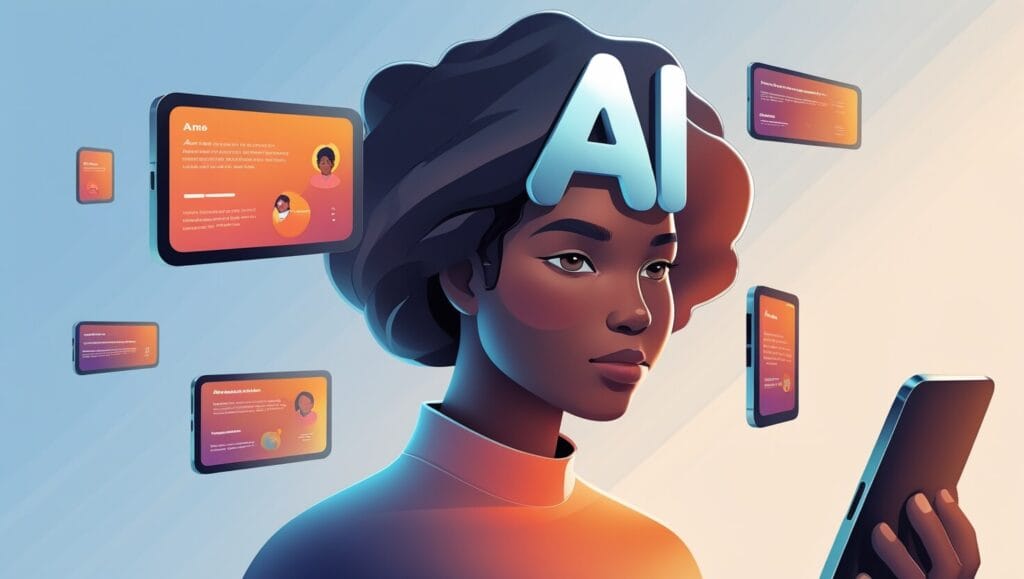
Microlearning has completely changed my perspective on how adults actually prefer to consume educational content in the workplace. Instead of forcing employees to sit through hour-long training sessions, AI in corporate learning breaks knowledge into digestible chunks that can be consumed when and where they’re needed most. It’s like having a personal learning assistant that delivers exactly the right information at exactly the right moment.
The intelligence behind effective microlearning goes far beyond just chopping up long training modules into smaller pieces. AI systems analyze work patterns, project timelines, and individual learning preferences to deliver micro-content when employees are most likely to need and retain the information. I worked with a software company where the AI learning platform would automatically send brief coding tutorials to developers right before they started working on projects that required those specific skills.
Just-in-time training powered by AI has solved one of the biggest frustrations I’ve encountered in corporate learning – the gap between when employees receive training and when they actually need to apply those skills. Traditional training programs often front-load information that employees might not use for months, leading to knowledge decay and wasted effort. AI systems solve this by monitoring work activities and delivering relevant training content precisely when it’s needed.
The personalization capabilities of AI-driven microlearning are incredibly sophisticated. These systems learn individual attention spans, optimal learning times, and preferred content formats to create customized micro-experiences for each employee. Some people absorb information better through short video clips, others prefer interactive quizzes, and some learn best from brief audio explanations they can listen to during commutes. The AI figures out these preferences and adapts content delivery accordingly.
I’ve seen microlearning AI systems become remarkably good at identifying teachable moments throughout the workday. For instance, when an employee encounters an error message they haven’t seen before, the system can immediately provide a brief tutorial on how to resolve it. When someone schedules a meeting with stakeholders from a different department, they might receive quick tips on cross-functional communication. These contextual learning moments are incredibly powerful because they provide immediate value and practical application.
The retention rates for AI-powered microlearning consistently outperform traditional training approaches in my experience. When employees receive small pieces of information that they can immediately apply in their work, the knowledge sticks much better than when they’re overwhelmed with comprehensive training modules. The AI reinforces learning through spaced repetition, automatically reviewing key concepts at optimal intervals to strengthen long-term retention.
Mobile optimization is crucial for effective microlearning, and AI systems excel at adapting content for different devices and contexts. Whether employees are learning on their phones during a coffee break, on tablets during travel, or through desktop notifications between meetings, the AI ensures that content is appropriately formatted and easily consumable. This flexibility dramatically increases engagement and completion rates.
Challenges and Ethical Considerations in AI Learning Systems
Implementing AI in corporate learning isn’t without its challenges, and I’ve learned some hard lessons about what can go wrong when these systems aren’t properly designed and managed. Data privacy concerns are probably the biggest issue I encounter when working with organizations. Employees are understandably nervous about AI systems tracking their learning behaviors, performance patterns, and skill gaps. The key is transparency and giving employees control over their data.
I worked with one company where initial resistance to their AI learning platform was fierce because employees felt like they were being constantly monitored and evaluated. We had to completely restructure the program to emphasize how the data was being used to support their development, not evaluate their job performance. Making it clear that learning analytics were separate from performance reviews was crucial for building trust and encouraging genuine engagement with the system.
Bias in AI algorithms is another significant concern that requires constant vigilance. These systems learn from historical data, which might reflect existing inequalities in training opportunities, promotion patterns, or performance evaluations. I’ve seen AI learning platforms inadvertently recommend different career development paths for men and women, or suggest that employees from certain backgrounds weren’t suitable for leadership training. Regular algorithm auditing and diverse training data sets are essential for preventing these issues.
The digital divide within organizations can also create problems with AI-powered learning systems. Not all employees have the same level of comfort with technology, and some might struggle with AI-driven platforms while others embrace them enthusiastically. I’ve learned to always implement these systems with robust support structures and alternative access methods to ensure that technological barriers don’t create learning inequalities.
Over-reliance on AI recommendations can sometimes stifle creativity and serendipitous learning opportunities. When systems become too good at predicting what employees should learn, they might miss unconventional skill combinations or innovative learning paths that could benefit both individuals and organizations. Maintaining human oversight and encouraging employees to explore beyond AI recommendations is important for fostering innovation and creative problem-solving.
The cost of implementing comprehensive AI learning systems can be prohibitive for smaller organizations, potentially creating competitive disadvantages. While prices are dropping, the initial investment in platforms, content development, and system integration can be substantial. I’ve worked with organizations to implement phased rollouts and focus on high-impact use cases to maximize return on investment while managing costs.
Change management challenges shouldn’t be underestimated when introducing AI in corporate learning. Employees who are comfortable with traditional training methods might resist new approaches, and managers who are used to evaluating learning through completion rates might struggle with more nuanced AI analytics. Successful implementation requires comprehensive change management strategies and ongoing communication about the benefits and proper use of AI learning systems.
What’s Next for AI in Corporate Learning
The future of AI in corporate learning is evolving so rapidly that even my predictions from last year already seem conservative. Natural language processing improvements are making AI tutoring systems incredibly sophisticated – I’m seeing platforms that can engage in complex Socratic dialogues with learners, ask probing questions to deepen understanding, and provide explanations that adapt to individual communication styles.
Emotional AI is another frontier that’s particularly exciting for corporate learning applications. These systems can detect frustration, boredom, confusion, and engagement through various signals including typing patterns, response times, and even facial expressions through webcam analysis. I worked with a beta system that could identify when employees were getting overwhelmed with complex technical content and automatically suggest taking breaks or switching to different learning modalities.
The integration of AI with augmented reality is creating incredible possibilities for on-the-job learning. Instead of pulling employees away from their work for training, AR systems can overlay instructional content directly onto their work environment. I’ve seen maintenance technicians receive step-by-step repair guidance through AR glasses, with AI systems providing contextual information based on the specific equipment they’re working on.
Collaborative AI learning is developing in fascinating ways, with systems that can facilitate peer-to-peer learning by identifying employees with complementary skills and knowledge gaps. These platforms create learning partnerships, suggest knowledge-sharing opportunities, and even organize informal learning groups based on common interests and development goals. It’s like having a matchmaking service for professional learning relationships.
Blockchain integration with AI learning systems is addressing credential verification and skill portability challenges. Employees can build verified digital portfolios of their learning achievements that travel with them throughout their careers, while organizations can trust that claimed competencies are legitimate. This development could revolutionize how we think about professional development and career progression.
The convergence of AI learning systems with broader workplace technologies is creating seamless learning ecosystems. Calendar systems that automatically schedule learning time based on workload patterns, project management tools that identify skill development needs for upcoming assignments, and performance management platforms that integrate learning recommendations with career planning conversations.
Quantum computing applications in AI learning are still theoretical but could enable incredibly complex personalization algorithms that consider thousands of variables simultaneously. These systems could optimize learning paths in ways that current technology can’t match, potentially revolutionizing how we understand individual learning differences and optimal educational approaches.
Making AI Learning Work in Your Organization
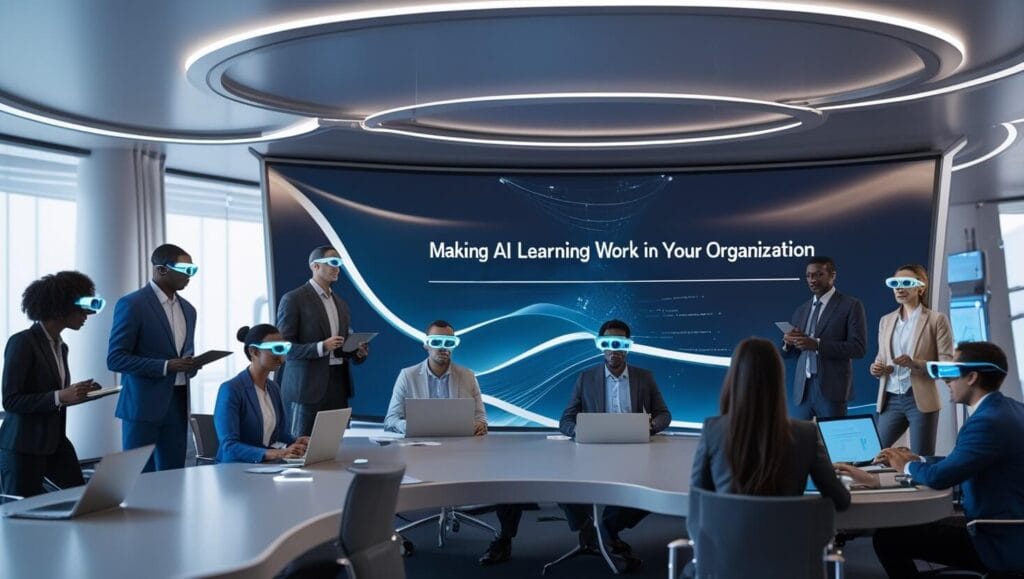
Successfully implementing AI in corporate learning requires careful planning, stakeholder buy-in, and a phased approach that builds confidence while demonstrating value. I’ve learned through trial and error that rushing into comprehensive AI learning systems often leads to resistance and poor adoption rates, while gradual implementation allows organizations to adjust and optimize as they learn.
Start with pilot programs focused on specific departments or skill areas where you can measure clear outcomes. I typically recommend beginning with technical training or compliance education because these areas have concrete success metrics and tend to generate quick wins that build enthusiasm for broader implementation. Choose early adopters who are excited about technology and can become internal champions for the AI learning platform.
Data preparation is absolutely crucial for successful AI implementation, but many organizations underestimate this requirement. Your AI learning system is only as good as the data it has to work with, so spend time cleaning up existing training records, performance data, and skill assessments. Inconsistent or incomplete data will lead to poor AI recommendations and frustrated users, undermining the entire initiative.
Integration with existing systems requires careful planning and often more time than anticipated. Your AI learning platform needs to communicate with HR systems, performance management tools, learning management systems, and potentially dozens of other workplace technologies. Map out these integration requirements early and budget appropriate time and resources for technical implementation.
Training your trainers and learning administrators is essential but often overlooked. These team members need to understand how AI systems work, how to interpret analytics and recommendations, and how to troubleshoot common issues. I’ve seen organizations successfully launch AI learning platforms only to have them fail because the support team couldn’t help employees when problems arose.
Communication strategy around AI implementation can make or break adoption rates. Employees need to understand how the AI will help them, what data is being collected, how their privacy is protected, and what the system can and cannot do. Avoid overpromising capabilities while clearly articulating the benefits they’ll experience. Regular communication during rollout helps address concerns and maintain engagement.
Measuring success requires establishing baseline metrics before implementation and tracking multiple indicators of effectiveness. Completion rates alone aren’t sufficient – monitor engagement levels, knowledge retention, performance improvements, and user satisfaction. I recommend quarterly reviews during the first year to identify issues and optimization opportunities before they become significant problems.
Cultural considerations vary significantly between organizations and can dramatically impact AI learning adoption. Some corporate cultures embrace technology quickly, while others prefer gradual change and extensive human support. Tailor your implementation approach to match your organization’s change management preferences and communication styles. What works in a tech startup might fail completely in a traditional manufacturing environment.
The AI Learning Revolution
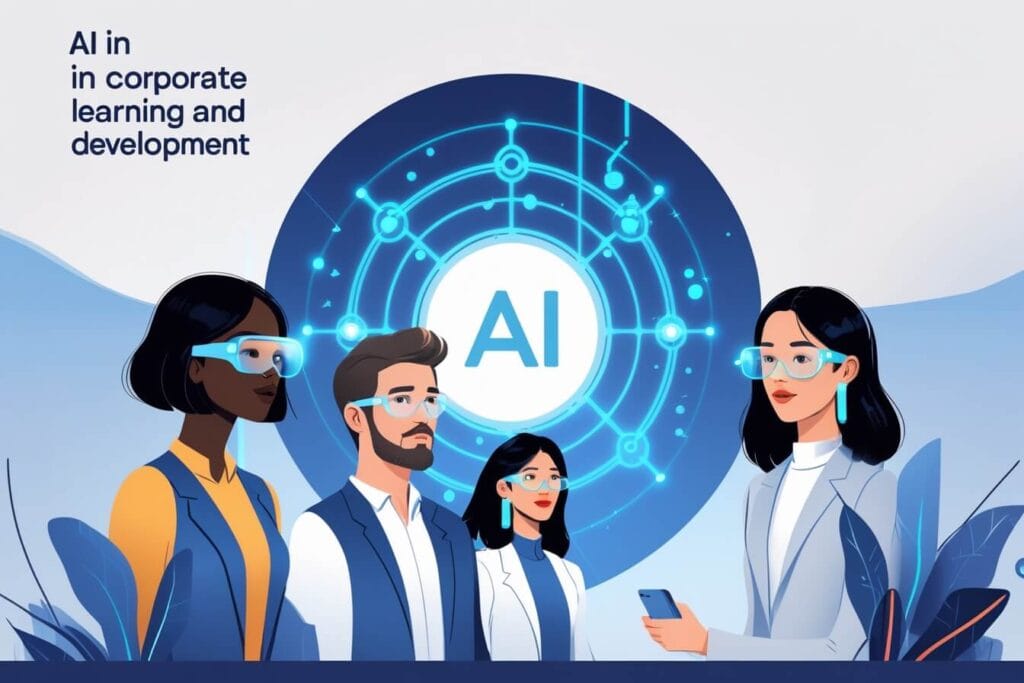
The transformation of corporate learning through artificial intelligence isn’t coming – it’s already here, and organizations that embrace these technologies are gaining significant competitive advantages through more skilled, engaged, and adaptable workforces. My experience implementing AI learning systems across diverse industries has convinced me that this isn’t just another training trend; it’s a fundamental shift in how we approach human capital development.
The results I’ve witnessed speak for themselves: higher engagement rates, improved knowledge retention, more efficient training delivery, and ultimately, better business outcomes. Companies using AI in corporate learning are not only training their employees more effectively but also predicting and preparing for future skill needs in ways that were impossible just a few years ago.
However, successful AI implementation requires thoughtful planning, adequate resources, and a commitment to addressing legitimate concerns about privacy, bias, and technological displacement. Organizations that rush into AI learning without proper preparation often face resistance and poor adoption rates, while those that take measured, strategic approaches see remarkable improvements in their learning and development outcomes.


